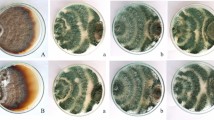Abstract
The mode of action of the fungicide metalaxyl againstPlasmopara halstedii, the causal agent of sunflower downy mildew, was studied following its application before, during and after artificial contamination of seedlings. The development of the fungus within the treated seedlings was examined microscopically and compared to that occuring in untreated genetically susceptible or resistant genotypes. Hypersensitive-like reactions and necrotic zones leading to the inhibition of fungus growth within the hypocotyl were observed for the three modes of application. This suggests that sunflower defence mechanisms activated by genetical resistance are also involved in the control of downy mildew by metalaxyl.
Similar content being viewed by others
References
Allard C (1978) Invasion et colonisation systémique de la plantule de tournesol (Helianthus annus L.) par lePlasmopara halstedii (Farl.) Berl. et de Toni. Annales de Phytopathologie 10: 197–217
Cahill DM and Ward EWB (1989) Effect of metalaxyl on elicitor activity, stimulation of glyceollin production and growth of sensitive and tolerant isolates ofPhytophthora megasperma f.sp.glycinea. Physiological and Molecular Plant Pathology 35: 97–112
Cahill DM, Morris PF and Ward EWB (1993) Influence of metalaxyl on abscissic acid levels in soybean hypocotyls infected withPhytophthora sojae. Physiological and Molecular Plant Pathology 42: 109–121
Cohen Y and Coffey MD (1986) Systemic fungicides and the control of oomycetes. Annual Revue of Phytopathology 24: 311–338
Davidse LC, Gerritsma OCM and Hofman AE (1981) Mode d'action du métalaxyl. Phytiatrie-Phytopharmacie 30: 235–244
Davidse LC, Hofman AE and Velthuis GCM (1983) Specific interference of metalaxyl with endogenous RNA polymerase activity in isolated nuclei fromPhytophthora megasperma f. sp.medicaginis. Experimental Mycology 7: 344–361
Fick GN and Zimmer DE (1974) RHA271, RHA273 and RHA274 sunflower parental lines for producing downy mildew resistant hybrids. Farm Research 32: 7–9
Gray AB and Sackston WE (1985) Early stages of infection of resistant and susceptible sunflower seedlings by three races ofPlasmopara halstedii. Canadian Journal of Botany 63: 1725–1729
Hickey EL and Coffey MD (1980) The effects of Ridomil onPeronospora pisi parasitizingPisum sativum: an ultrastructural investigation. Physiological Plant Pathology 17: 199–204
Johansen DA (1940) Plant Microtechniques. McGraw-Hill Book Co Inc. New York.
Lazarovits G and Ward EWB (1982) Relationship between localized glyceollin accumulation and metalaxyl treatment in the control of Phytophthora rot in soybean hypocotyls. Phytopathology 72: 1217–1221
Melero-Vara JM, Garcia-Baudin CL, Herrera C and Jimenez-Diaz RM (1982) Control of sunflower downy mildew by metalaxyl. Plant Disease 66: 132–135
Mouzeyar S, Tourvieille De Labrouhe D and Vear F (1993) Histopathological studies of resistance of sunflower (Helianthus annuus L.) to downy mildew (Plasmopara halstedii). Journal of Phytopathology 139: 289–297
Mouzeyar S, Tourvieille De Labrouhe D and Vear F (1994) Effect of host-race combination on resistance of sunflower (Helianthus annuus L.) to downy mildew (Plasmopara halstedii). Journal of Phytopathology 141, 249–258
Oros G and Viranyi F (1987) Glasshouse evaluation of fungicides for the control of sunflower downy mildew (Plasmopara halstedii). Annals of Applied Biology 110: 53–63
Stössel P, Lazarovits G and Ward EWB (1982) Light and electron microscopy of Phytophthora rot in soybeans treated with metalaxyl. Phytopathology 72: 106–111
Vear F (1978) Réaction de certains génotypes de tournesol résistants au Mildiou (Plasmopara helianthi) au test de résistance sur plante. Annales de l'Amélioration des Plantes 28: 327–332
Viranyi F and Oros G (1991) Developmental stage response to fungicides ofPlasmopara halstedii (sunflower downy mildew). Mycological Research 95: 199–205
Ward EWB, Lazarovits G, Stössel P, Barrie SD and Unwin CH (1980) Glyceollin production associated with control of Phytophthora rot of soybeans by the systemic fungicide, metalaxyl. Phytopathology 70: 738–740
Wehtje G, Littelfield L and Zimmer DE (1979) Ultrastructure of compatible and incompatible reactions of sunflower toPlasmopara halstedii. Canadian Journal of Botany 57: 315–323
Author information
Authors and Affiliations
Rights and permissions
About this article
Cite this article
Mouzeyar, S., Vear, F. & de Labrouhe, D.T. Microscopical studies of the effect of metalaxyl on the interaction between sunflower,Helianthus annuus L. and downy mildew,Plasmopara halstedii . Eur J Plant Pathol 101, 399–404 (1995). https://doi.org/10.1007/BF01874853
Accepted:
Issue Date:
DOI: https://doi.org/10.1007/BF01874853




